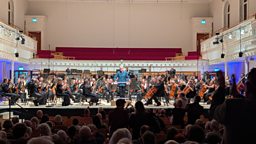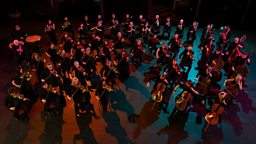Sir James MacMillan's Concerto for Orchestra 'Ghosts'

MacMillan's Concerto for Orchestra 'Ghosts'
Watch the full performance on ÃÛÑ¿´«Ã½ iPlayer
In February 2025, composer Sir James MacMillan conducted the Scottish premiere of his Concerto for Orchestra at Glasgow City Halls with the ÃÛÑ¿´«Ã½ Scottish Symphony Orchestra.
Watch the full performance now on ÃÛÑ¿´«Ã½ iPlayer
Immediately before the performance, MacMillan was presented onstage with Honorary Membership of the Royal Philharmonic Society. Awarded since 1826, this honour recognises individuals who have devoted their lives to music and to uplifting others through it, with previous recipients including Brahms, Wagner and more recently, Evelyn Glennie and Stephen Sondheim.
The Scottish premiere of MacMillan's Concerto for Orchestra 'Ghosts' followed performances of eight new orchestral works by younger Scottish composers who MacMillan has mentored through his festival, The Cumnock Tryst.
The Concerto for Orchestra received its world premiere in September 2024, performed by the London Symphony Orchestra under its Chief Conductor Antonio Pappano.
Who is Sir James MacMillan?
James MacMillan is Scotland's pre-eminent composer of his generation whose music draws on an eclectic range of influences from football, folk traditions, faith and bold contemporary sounds. His breakthrough work, The Confession of Isobel Gowdie, was premiered at the 1990 Proms by the ÃÛÑ¿´«Ã½ Scottish Symphony Orchestra and confronts the tragedy of the Scottish witch trials with searing intensity.
Inspired by his Catholic faith, MacMillan made history when his Stabat Mater became the first piece of music ever to be live-streamed from the Sistine Chapel in 2018. Rooted in his native East Ayrshire, MacMillan founded The Cumnock Tryst festival in 2014, not only bringing many of the world’s finest musicians to his hometown, but also championing local talent and nurturing the musical life of the Ayrshire community.

In the Press...
- “Rich in melody, “Ghosts” is MacMillan at his most approachable and it is a piece surely destined for regular performance…The ÃÛÑ¿´«Ã½ SSO played it quite brilliantly for him.” – Vox Carnyx
- “a high energy helter-skelter… The excitement of ferocious writing, pounding rhythms and nasal brass fanfares was enormously enjoyable.” – Bachtrack
- “a bespoke vehicle for the virtuosity of orchestral players – an opportunity grabbed with enthusiasm by the musicians of the ÃÛÑ¿´«Ã½ SSO.” – The Herald
- “Rapid, rhythmic, syncopated and jazzy, thrilling and exciting… an oasis of tranquillity. The ‘Concerto for Orchestra’ is a masterpiece.” – Edinburgh Music Review
In his own words...
My Concerto for Orchestra is in one continuous, through-composed movement, lasting about 25 minutes. It has a subtitle, ‘Ghosts’ – as the music seems to be haunted by other, earlier musical spirits and memories. Right from the start, we can hear allusions to folk-dance forms, an eastern European hymn and Scottish traditional music.
Various chamber groups emerge from within the orchestral fabric and there is much focus on soloistic playing throughout. Duets and trios are important – the work opens with an 11-note theme being thrown between two trombones, and later there are other duos for clarinets, piccolo and tuba, and two violas.
Trios are also prominent – three bassoons at one point, as well as a quotation from Beethoven’s ‘Ghost’ Trio (which gives this work its subtitle), and allusions to the famous Debussy Trio for flute, viola and harp. Also in the spotlight at various points is a string quartet, a wind quintet and a brass sextet. The work has four main interlocking sections. The first is fast and presents most of the initially important materials. The second section is slow and elegiac, and operates like a two-part canon, presenting many different combinations of the two lines, sometimes fully orchestral, other times soloistic and in chamber dimensions.
The third section, a scherzo, is marked presto. Its main ‘refrain’ is an energetic, rhythmic theme based on my memories of the dance forms my children used to listen to when they were teenagers … The episodes between these focus on some of the chamber groups mentioned above. Eventually we hear a brief moment from the Beethoven ‘Ghost’ Trio, but the piano is
replaced by a celesta. This is then smudged into the Debussy memory and finally a new trio (cor anglais, bass clarinet and vibraphone) joins, all forming a trio of trios.
The Concerto culminates in an Allegro finale, based on an unsettled and compulsive compound rhythm, containing nasal fanfares on horns and counterrhythmic interjections on trumpets, piccolo and xylophone. The music eventually subsides to a more serene conclusion, where the hymnic theme (which has haunted the music throughout) is given its final statement.
Programme note © James MacMillan

